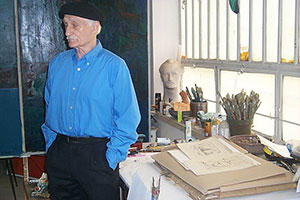
Vilna, 1944
Pencil and charcoal on paper
24.1 x 32.5 cm
Gift of the Artist
 Alexander Bogen was born in Tartu, Estonia. Some two years later, after his father had been enlisted in the Red Army and killed in battle, the family moved to Vilna. In 1936, he started his studies at the city's Academy of Art. With the launch of Operation Barbarossa, his studies were interrupted, and Bogen and his wife tried to escape. They were caught and deported to the Swieciany Ghetto, and later to the Vilna Ghetto. In July 1943, Bogen escaped from the Vilna Ghetto to the Narocz forests, where he joined the partisans. Bogen was sent by the partisans to secretly infiltrate the Vilna Ghetto in order to organize groups of youth and smuggle them out to augment the fighting force. His wife and his mother-in-law also fled with him. Additionally, he was given the task of depicting in his sketches the life and actions of the partisans. After the war, the couple returned to Vilna, where Bogen completed his studies, and was afterwards appointed professor at the Academy of Art in Lodz. The couple immigrated to Israel in 1951. Bogen taught art at the Hebrew University, and served as chairman of the Association of Painters and Sculptors in Israel. He passed away in Tel-Aviv.
Alexander Bogen was born in Tartu, Estonia. Some two years later, after his father had been enlisted in the Red Army and killed in battle, the family moved to Vilna. In 1936, he started his studies at the city's Academy of Art. With the launch of Operation Barbarossa, his studies were interrupted, and Bogen and his wife tried to escape. They were caught and deported to the Swieciany Ghetto, and later to the Vilna Ghetto. In July 1943, Bogen escaped from the Vilna Ghetto to the Narocz forests, where he joined the partisans. Bogen was sent by the partisans to secretly infiltrate the Vilna Ghetto in order to organize groups of youth and smuggle them out to augment the fighting force. His wife and his mother-in-law also fled with him. Additionally, he was given the task of depicting in his sketches the life and actions of the partisans. After the war, the couple returned to Vilna, where Bogen completed his studies, and was afterwards appointed professor at the Academy of Art in Lodz. The couple immigrated to Israel in 1951. Bogen taught art at the Hebrew University, and served as chairman of the Association of Painters and Sculptors in Israel. He passed away in Tel-Aviv.
Bogen, who took part in the battles for the liberation of Vilna, returns to his devastated childhood city and depicts the ghetto ruins. Thus he grieves over the destruction of "Jerusalem of Lithuania", that before the war was an important center of Jewish culture.